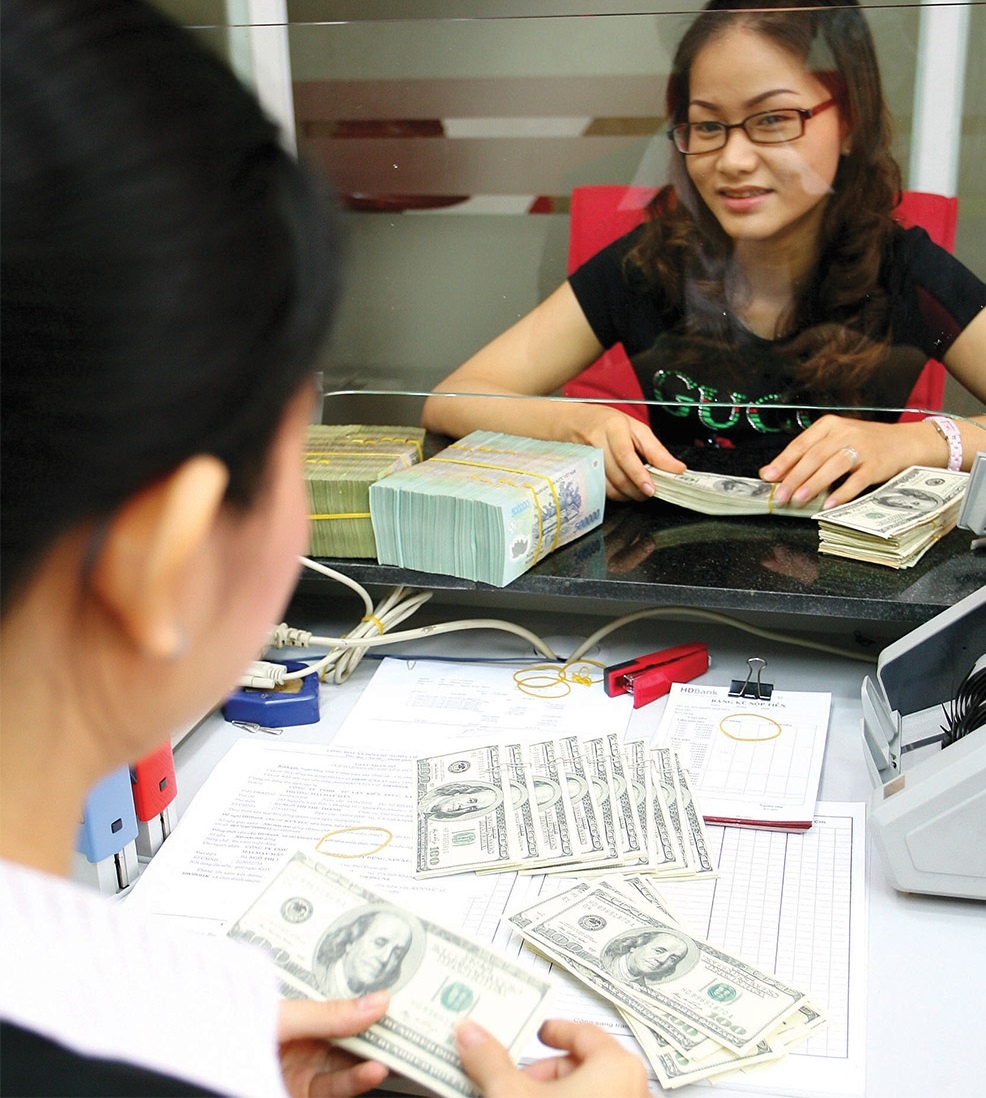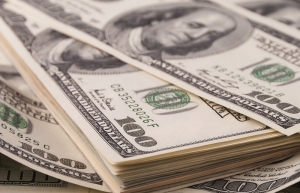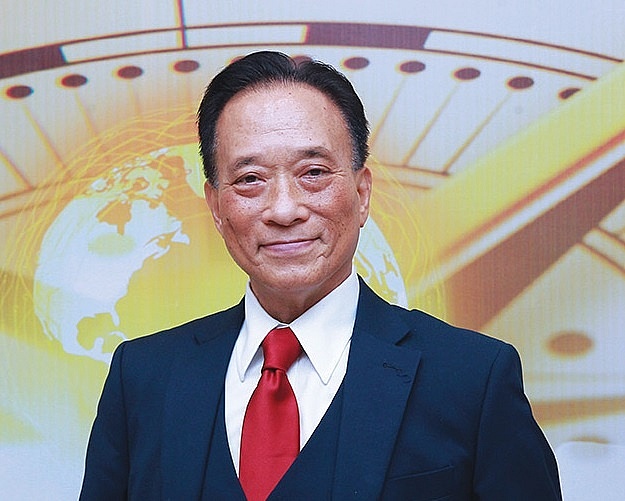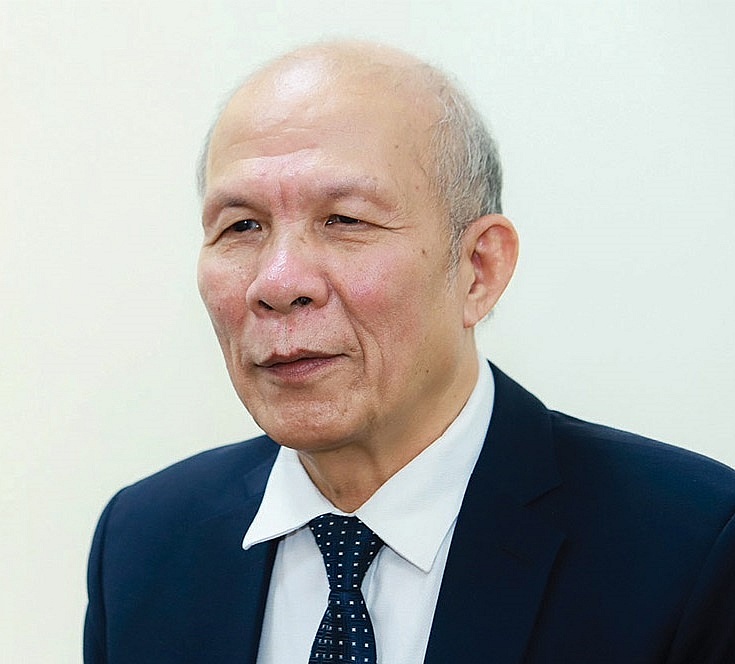Rate policies to be managed strategically
On December 29, the central exchange rate announced by the State Bank of Vietnam (SBV) stood at VND24,324 to a US dollar, an increase of 1.9 per cent since the beginning of the year. Meanwhile, the USD exchange rate at commercial banks was around VND25,240 for buying and VND25,540 for selling, up 4.2 per cent year-to-date, a significant rise compared to previous years.
 |
| USD strength will continue to influence exchange rates, photo Le Toan |
In its December strategic report, SSI projected the exchange rate to reach 25,800 VND/USD in 2025, continuing its upward trend. This movement could be influenced by both international and domestic economic policies.
“2025 marks a pivotal year as it concludes the 2021-2025 Economic Development Plan and serves as a cornerstone for the upcoming era, with comprehensive reforms focusing on enhancing growth quality to position Vietnam as an upper-middle-income country by 2030,” noted SSI in its report.
Looking to 2025, macroeconomic indicators remain promising. Real GDP growth is projected to hold steady at 7-7.5 per cent, while inflation is expected to rise slightly to 3.8 per cent. Export and import turnover are anticipated to reach $451 billion and $389 billion, respectively.
Cautious management
Nominal retail sales are forecast to grow by 9.5 per cent, reflecting strengthening domestic demand. Public investment is set to surge by 16.7 per cent, playing a critical role in advancing development projects.
“In this context, exchange rate fluctuations not only exert pressure on the economy but also significantly impact businesses, especially those with substantial international trade activities or foreign-currency-denominated debts. Thus, enterprises must prioritise effective exchange rate risk management strategies to mitigate negative effects,” an SSI representative said.
In Vietnam, credit growth reached 11.9 per cent by the end of November last year, while deposit growth stood at just 10.6 per cent, including approximately 2 per cent growth in the interbank market from bank bond issuances, leading to a significant mismatch.
Amid the SBV’s cautious liquidity management in the interbank market, interest rates are expected to remain elevated for an extended period to curb the disparity between the VND and the USD. Over time, this is likely to influence market interest rates for businesses and individuals.
Additionally, given the country’s thin foreign exchange reserves, the SBV faces a trade-off between stabilising the exchange rate and controlling interest rates. As emphasised by the SBV governor in a statement to the National Assembly last October, maintaining exchange rate stability is key to investor confidence.
Consequently, alongside potential adjustments to exchange rate bands, the SBV may raise policy rates or tighten credit growth caps during the first half of 2025.
At the beginning of January, the new US administration could bring unconventional economic policies, particularly on tariffs and trade. Combined with the Federal Reserve’s cautious approach to its rate-cutting roadmap, these factors have driven the USD to appreciate globally.
“The new US president may impose high import tariffs on countries with trade surpluses with the US, including Vietnam. If tariffs on China reach 60 per cent and are at least 25 per cent for other countries, Vietnam’s exports to the US could face significant challenges, potentially hampering economic growth,” said Dr. Nguyen Tri Hieu, director of the Institute for Research and Development of Global Financial and Real Estate Markets.
Market resilience
According to Vietcombank Securities’ 2025 outlook report published last week, the strength of the USD will continue to be a major factor influencing exchange rates, with the VND expected to depreciate by approximately 3 per cent against the USD throughout 2025.
The report highlighted that the global trend of monetary easing and interest rate cuts by central banks has begun and is likely to continue. Meanwhile, with positive economic growth prospects and effectively controlled inflation, the SBV is well-positioned to implement flexible monetary policies, contributing to macroeconomic stability.
“Specifically, the resilience of the US labour market and service sector suggests that the Federal Reserve is likely to delay cutting interest rates. This will help maintain the USD’s strength relative to other currencies. Additionally, geopolitical conflicts are driving demand for safe-haven assets, with the USD being a preferred choice,” said the report.
“Nonetheless, the foreign exchange market still holds positive elements. The easing monetary policies of global central banks and capital flows seeking stable macroeconomic environments, such as Vietnam, are notable bright spots.”
As for 2025 policies, Deputy Governor of the SBV Dao Minh Tu stated at a banking sector task implementation conference on December 14 that the SBV would continue to monitor market trends and domestic and international economic developments to effectively manage monetary policy. This approach aims to align monetary policy with fiscal policy to support economic growth, foster business, and contribute to macroeconomic stability and inflation control.
“Firstly, interest rate policies will be managed in alignment with market trends, macroeconomic conditions, inflation, and monetary policy goals. Secondly, exchange rate policies will be adjusted flexibly to suit market conditions and macroeconomic objectives, coordinating with other monetary policy tools to stabilise inflation and the economy,” said Tu.
“We also urge service providers to enhance safety measures for online payments and bank card transactions to protect customers’ rights and interests while boosting public financial literacy through comprehensive communication campaigns.”
| Dr. Nguyen Tri Hieu, director, Institute for Research and Development, Global Financial and Real Estate Markets
2025 is unlikely to be a stable year, as significant global economic shifts, including inflation, monetary policy changes, advancements in fintech, and global threats, will profoundly impact Vietnam. Vietnam’s financial and banking sector will face considerable challenges, especially given the economy’s reliance on global factors, notably from the US. With approximately 80 per cent of Vietnam’s foreign currency transactions, ranging from trade payments, foreign investments, and interbank settlements, tied to the USD, fluctuations in its value directly affect domestic monetary policies, particularly the exchange rate. A strengthening USD would exert upward pressure on exchange rates, whereas a weaker USD, driven by US Federal Reserve interest rate policies, could ease these pressures, stabilising the exchange rate at more manageable levels. Currently, the USD Index, measuring the USD’s value against six major currencies, hovers around 107-108, a notably high level, pushing the USD/VND exchange rate higher. As 2025 unfolds, Vietnam’s economy will remain heavily influenced by the US monetary policies, underlining the need for strategic and flexible domestic financial management. Financial plans should include a contingency fund to address unforeseen circumstances, crisis management strategies for business operations, and the establishment of economic and financial alliances to collectively navigate challenges during difficult times. Dr. Dinh Trong Thinh, economist
Vietnam’s growing reliance on credit for economic growth remains a concern, with the credit-to-GDP ratio nearing 140 per cent, signalling potential financial stability risks. The robust growth of the US economy has caused the USD to continue strengthening, despite global interest rate and monetary policy changes. The current USD exchange rate has reached 108.8 per cent, putting pressure on the VND exchange rate. On the positive side, banks have focused on risk prevention through reserves and restructuring non-performing loans (NPLs). Despite NPLs rising to nearly 5 per cent in November, measures like provisioning and debt restructuring are expected to lower them to around 1.9 per cent, staying below the 2 per cent target, ensuring financial stability. Looking to 2025, I believe it is time to conclude special support policies, such as Circular No.02/2023/TT-NHNN. The economy has stabilised and is gradually returning to pre-pandemic levels. This is the right time to restore more transparent and normal economic mechanisms. The end of Circular 02 may create challenges, as businesses will face the reclassification of bad debts. However, this will allow for a clearer, more thorough resolution of financial issues. While temporary difficulties may arise, banks, with adequate preparations and measures already in place, are well-equipped to navigate these challenges. Transparency in NPL management will help build trust with both domestic and foreign investors, encouraging foreign direct investment into Vietnam. |
 | Monetary policies narrow after rate dip As interest rates have fallen dramatically during the first 10 months of the year, the State Bank of Vietnam’s leeway for monetary policy has been squeezed to a great extent, with likely solutions possible to foster growth of the public and private sectors while focusing on industries and services with highest development priority. |
 | Policies needed to boost production linkage, localisation rate: insiders Policies are needed to boost the number of domestic enterprises participating in the supply chain of multinational companies, and a boost is necessary in the localisation rate of the processing and manufacturing industry, which now remain modest, insiders said. |
What the stars mean:
★ Poor ★ ★ Promising ★★★ Good ★★★★ Very good ★★★★★ Exceptional
Related Contents
Latest News
More News
- As global green supply chain reshapes, will Vietnam be left behind? (December 19, 2025 | 08:00)
- Banks gear up for massive capital increases (December 18, 2025 | 17:04)
- Securing capital and efficiency for Vietnam’s 2026-2030 growth ambitions (December 17, 2025 | 10:00)
- Energy sector in need of blended finance mechanisms (December 17, 2025 | 09:00)
- Vietnam still has room to mobilise capital for sustainable growth (December 17, 2025 | 08:57)
- Long-term capital seen as key hurdle to green growth (December 16, 2025 | 08:00)
- Gold prices swing amid tax debate and import uncertainty (December 15, 2025 | 18:04)
- Agribank frames bank credit as catalyst for green growth (December 15, 2025 | 17:59)
- Vietnam’s green transition demands collective financial action (December 15, 2025 | 12:00)
- VIR workshop highlights capital and policy for sustainable development (December 15, 2025 | 11:00)



 Tag:
Tag:





















 Mobile Version
Mobile Version